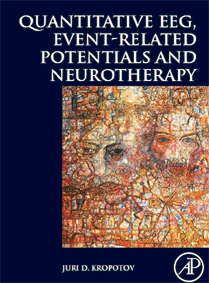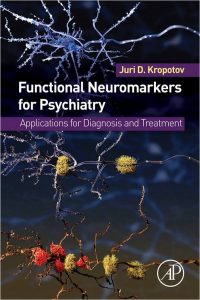
Functional Biomarkers in Psychiatry & Neurology Workshop
This 4 day workshop is given by:
Prof. Yury Kropotov
Institute of the Human Brain of Russian Academy of Sciences
We do not have any plans to run any workshops for now… Sorry
The Workshop:
° The goal of the workshop is to teach attendees how to improve their diagnostic and treatment tools by using a newly emerged technology of Quantitative EEG, event related potentials and neurotherapy.
° The attendees are required to bring laptops with them. At the workshop the attendees will be supplied by an educational software and EEG files from the HBI (Human Brain Index) reference database.
° Each day will consist of two parts:
Morning: theoretical usually by lectures and practice with software on EEG files taken from the HBI reference database and afternoon; working with hardware/software, recording EEG and analyzing EEG files recorded during the workshop.
° The attendees will be supplied with hardware for recording EEG. Each attendee will get the opportunity to record and analys EEG and ERP by themselves.
Day 1:
Morning
Topics:
° Generators of EEG rhythms.
° Background EEG as a reflection of cortical self regulation.
° What does clinical EEG mean?
° Pathological EEG patterns (slow waves, spikes, paroxysms….) in epilepsy, brain tumors, and some other brain disorders.
° Mapping potentials
° Generating Slow Resolution Electromagnetic Tomography (LORETA and s-LORETA) from the spectral maps.
The aim is teach attendees the foundations of clinical EEG, namely:
1) neuronal basics of brain rhythms
2) methods of recording and montaging,
3) how to distinguish non-EEG artifacts from EEG records,
4) to correct artifacts using available software,
5) to distinguish pathological EEG patterns by means of visual inspection as well as by means of automated tools.
6) to use brain maps and s-LORETA imaging for depicting the data.
Procedure: lecture (power point presentation is supplied), practice with EEG records on healthy subjects and patients from the HBI database (software and EEG files are supplied).
Afternoon
Topics:
° recording EEG in resting state (eyes open, eyes closed, hyperventilation)
° visual inspection of the EEG recording
° artifact correction
° automated spike detection.
the aim is to teach attendees:
1) to place electrodes on the patients head according to 10-20 system,
2) to start, end and store an EEG recording,
3) to be able to use the built-in database to manage the datasets,
4) to remontage the recording.
Procedure: the attendees will be divided into groups. Each group will be supplied with hardware/software for recording and analysis. One of the attendees will serve as a subject (to be recorded) while the others will record.
Day 2:
Morning
Topic:
° quantitative EEG as a method for neuro-metrics
° qEEG-endophenotypes (biological markers) in the healthy population
° qEEG-endophenotypes in brain disorders
The aim is to teach attendees methods of spectral analysis, including
1) Fourier and wavelet transformations,
2) coherence,
3) event related de-synchronization, as well as to show how these methods enable us to reveal
4) QEEG-endophenotypes of brain disorders such as ADHD, dyslexia, anxiety.
Procedure: lecture, practicing with EEG records on healthy subjects and patients from the HBI database.
Afternoon
Topic:
° Spectral and coherence analysis of EEG recorded on the first day
° Comparing spectral characteristics of recorded EEG with the normative data of the HBI reference database.
the aim is to teach attendees:
1) to remontage the recording into the HBI database montage,
2) to perform spectral and coherence analysis,
3) to compare the results of the analysis with the HBI database,
4) to interpret the results.
Procedure: the attendees will be divided into groups. Each group will be supplied with software for analysis of the EEG of the group. Spectra, coherence, theta/beta ratios, asymmetry maps for EEGs recorded in the first day will be computed and analyzed.
Day 3:
Morning
Topics:
° Event related potentials (ERPs) as markers of stages of information flow in the brain.
° Association of ERP components with functioning of brain systems.
° Reflection of dysfunctioning of brain systems in ERPs components.
The aim is to teach attendees methods of Event Related Potentials, including
1) averaging technique,
2) Independent Component Analysis (ICA),
3) to show the discriminative power of ERPs in ADHD, dyslexia and traumatic brain injury etc.
Procedure: lecture, practicing with EEG records on healthy subjects and patients from the HBI database.
Afternoon
Topic:
° Recording of EEG in a Visual Contingent Performance Task (VCPT).
° Preprocessing EEG
° Computing ERPs by averaging techniques
° Comparison behavioral of parameters (omission and commission errors, latencies and variances of responses) with the normative data of the HBI database
° Comparison of ERPs with the HBI database
° Comparison of ICA components of ERPs with the normative data.
The aim is to teach attendees:
1) to use Psytask software for presenting tasks provided with the HBI database,
2) to record EEG in one of the tasks (such as VCPT),
3) to compute ERPs and behavioral parameters,
4) to analyze ERPs visually and to make maps was well as LORETA images of ERPs components,
5) to compare ERPs and ERP components with the HBI reference database.
Procedure: the attendees will be divided into groups. Each group will be supplied with hardware/software for recording and analysis. One of the attendees will serve as a subject (to be recorded) while the others will do recording. EEG in the VCPT task will be recorded and analyzed.
Day 4:
Morning
Topics:
° Neurofeedback and tDCS as tools of neurotherapy
° Neurotherapy for peak performance in healthy subjects
° Neurotherapy for correcting cortical dysregulation in brain disorders
° Neurotherapy for correcting disorders of information flow.
The aim is to teach attendees methods of neurotherapy, including
1) QEEG-based neurofeedback,
2) s-LORETA neurofeedback,
3) ICA-neurofeedback,
4) ERP-based neurofeedback,
5) transcranial Direct Current Stimulation,
6) Transcranial Magnetic Stimulation (TMS).
Procedure: lectures, practicing with EEG records on patients from the HBI database and constructing neurotherapy protocols.
Afternoon
Topics:
° Analysis of EEG records made during the first days.
° Constructing neurotherapy protocols for peak performance by using the recorded EEG files.
° Analysis of EEG records of patients from the HBI reference database.
° Constructing neurotherapy protocols for treatment.
The aim is to teach attendees to use the HBI reference databse for construction of protocols for neurotherapy.
Procedure: attendees will be divided into groups. Each group will be supplied with an HBI database. The records made during the first days will be analyzed and neurofeedback protocols for peak performance will be suggested. Several records from patients of the HBI database will be analyzed.
Contact Us
[contact-form-7 id=”3″ title=”Contact form 1″]
Tony Steffert
47 c Christchurch Av.
London, NW6 7BB
W: qeeg.co.uk
E: tony@qeeg.co.uk
P: + 44 (0) 7966 484 289


Quantitative EEG, event related potentials and neurotherapy
By: Professor Juri D. Kropotov
While the brain is ruled to a large extent by chemical neurotransmitters, it is also a bioelectric organ. The collective study of Quantitative ElectroEncephaloGraphs (QEEG-the conversion of brainwaves to digital form to allow for comparison between neurologically normative and dysfunctional individuals), Event Related Potentials (ERPs – electrophysiological response to stimulus) and Neurotherapy (the process of actually retraining brain processes to) offers a window into brain physiology and function via computer and statistical analyses of traditional EEG patterns, suggesting innovative approaches to the improvement of attention, anxiety, mood and behavior.
The volume provides detailed description of the various EEG rhythms and ERPs, the conventional analytic methods such as spectral analysis, and the emerging method utilizing QEEG and ERPs. This research is then related back to practice and all existing approaches in the field of Neurotherapy – conventional EEG-based neurofeedback, brain-computer interface, transcranial Direct Current Stimulation, and Transcranial Magnetic Stimulation – are covered in full.
While it does not offer the breadth provided by an edited work, this volume does provide a level of depth and detail that a single author can deliver, as well as giving readers insight into the personl theories of one of the preeminent leaders in the field.
Functional neuromarkers for psychiatry
By: Professor Juri D. Kropotov
Mental illness represents the biggest challenge for modern health care systems. Recent advances in neuroscience have allowed scientists to explore functional neuromarkers of psychiatric disorders. The decades of brain and brain discovery (1990-2010) are followed by the decade of translation that focuses on application of neuromarkers for providing an early detection, prevention, as well as a personalized care for patients with mental problems. The main goal of the book is to introduce the neuroscience methodology into psychiatric practice.
The functional neuromarkers analyzed in the book include brain activation patterns revealed by functional magnetic resonance imaging (fMRI), positron emission tomography (PET), quantitative electro-encephalography (qEEG) and event-related potentials (ERPs). To be used in clinical practice an ideal neuromarker must have a diagnostic sensitivity and specificity higher that 80%, to be reliable, reproducible, and inexpensive to measure, non-invasive, and simple to perform, and confirmed by at least two independent studies. The functional neuromarkers for ADHD, schizophrenia and obsessive-compulsive disorder are reviewed in detail.
The book is based on the author’s experience in search for functional neuromarkers in the healthy and diseased brain. The book focuses on recently emerged methods of analysis of EEG and ERPs with the goals of 1) elucidating neuronal mechanisms of generation of EEG spontaneous rhythms, and 2) determining functional meaning of ERP components in cognitive tasks. The mechanisms of neuromodulation methods such as Transcranial Magnetic Stimulation (TMS), Transcranial Direct Current Stimulation (tDCS), Deep Brain Stimulation (DBS) and neurofeedback are presented. A separate part of the book is dedicated to application of the whole methodology for 1) diagnosis, 2) personalized neurotherapy and 3) monitoring the results of treatment of ADHD, schizophrenia and obsessive-compulsive disorder.

